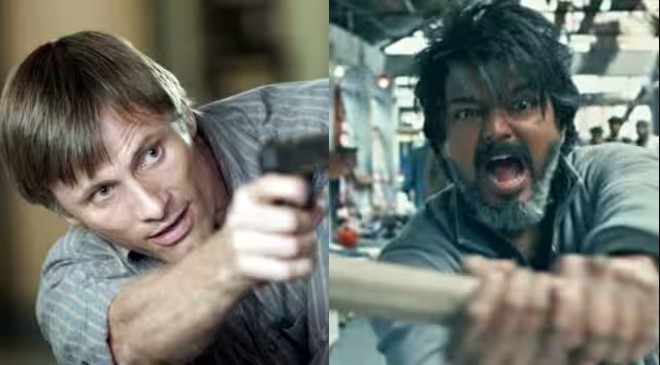The new-gen Tamil filmmakers don’t enjoy the same luxury as the old ones like AR Murugadoss to unofficially remake Hollywood movies in India anymore. Ghajini wouldn’t be possible today without credit to Christopher Nolan. The more Indian cinema is exposed to the world (and vice versa), the more scrutiny it has to endure. Hence, it is natural that Lokesh Kanagaraj starts Leo with credit to David Cronenberg’s A History of Violence (2005). But that was unnecessary. A History of Violence itself didn’t have a novel story to start with. It is one of the oldest action-hero stories around – a story of a man with a terrible past. From Amitabh Bachchan’s Hum to Rajinkanth’s Baashaa to Kamal Haasan’s Vikram, many films (even before A History of Violence) are derivative of this age-old story (that has been exploited by filmmakers and novel writers across the world).
Read More:-Raj Kundra reveals Shilpa Shetty’s reaction to his film debut: ‘Tu acting kar lega?’
Hence, David Cronenberg nor John Wagner, the author of the graphic novel of the same name (based on which A History of Violence was made), owns the story. Also, Cronenberg’s film is not about the story, it is about the treatment. It is about the central character Tom Stall (Viggo Mortensen) aka Joey. It is about who really is the protagonist. Is he the unassuming family man running a quaint cafe? The person who battled and won the monster in him. Or is he the monster with a penchant for killing, walking around in sheep’s skin? A History of Violence is more of a psychological drama than an action film. We get no such ponderings watching Leo because it is a trademark Tamil star vehicle that pretends to be something more than it is.
Read More:-Vivek Agnihotri REMOVES Karan Johar From National Film Award Winners Pic Amid Feud, Post Goes Viral
Now, let it be clear that Leo isn’t an attempt by Lokesh Kanagaraj to emulate David Cronenberg (that would have been a far better film). Lokesh tries to use A History of Violence to sell a Tamil masala film, with less spice, maybe. He should have chosen Bob Odenkirk’s Nobody instead because A History of Violence has a texture that’s hard to make in an industry like Tamil cinema and with a huge star like Vijay. Tamil cinema is in a way a rigged game. A lot of factors are predetermined even before the writer puts his pen on his paper. Lokesh, in one of the many promotional interviews, said Leo is 100 per cent his film. That is supposed to mean that he hasn’t made any compromise. However, the director later adds that songs are incorporated into films to meet the marketing need. That’s a part of the rigged game.
Read More: Anushka Sharma’s Baby Bump Spotted? Viral Video With Virat Seemingly CONFIRMS Second Pregnancy
Secondly, sensuality and lust play a huge part in A History of Violence. In a scene, Edie Stall (Maria Bello) takes her husband Tom to her parents’ house for steamy sex. She wears her school sports jersey before entering the attic room to spice up things. There’s a lot to this seen on top of being erotic. It’s Edie’s way of reliving her teenage years with her husband who wasn’t around that time. It is also about the hidden kinks of a responsible wife and a mother of two. It is about things below the surface. In essence, it’s about the very nature of humans that Cronenberg deals with in the movie. Later, sex again becomes a bridge to bring together Edie and Tom, once the latter’s true colour is out. The kinky sex gets replaced by angry sex. Though the two characters are not reconciled, Edie finally gets to ‘know’ Joey. It is impossible to imagine Trisha in a college jersey enacting the scene in Leo because that would be too much for Tamil cinema. Instead, we are to consider the kissing scene in the film to be bold.
Read More: Ankita Lokhande Makes BIG Statment, Says ‘I’d Never Have Done Bigg Boss 17 If…’ | Exclusive
However, these are not entirely the shortcomings of Lokesh Kanagaraj, but the cultural limitations. Leo was criticised for glorifying smoking. That’s where we are still at. While society can be blamed for such curtailing, nothing explains the way Lokesh has written his Parthiban and Leo. The biggest problem with Leo is that there’s no difference between Parthi and Leo. Now, I am not expecting a cowardly Ambi to Anniyan transformation, but there needs to be a distinction between the two. Parthi is as violent as Leo from the word go. He bludgeons everyone he fights with no sense of remorse, which is not expected of Leo but of Parthiban. Such nuanced writing is the difference between A History of Violence and Leo. There isn’t a scene in the American film where Joey is shown to be enjoying all the violence. Though characters keep telling him he is the ‘crazy one’. All we get is a minimalistic expression from Viggo Mortensen. Even towards the end, when the family accepts him as he is, he exudes guilt and regret. On the other hand, Leo ends on a celebratory note that undoes the whole point. It is not about the story anymore. It ends up being about the hero–doesn’t matter if he is a good or a bad guy.



































